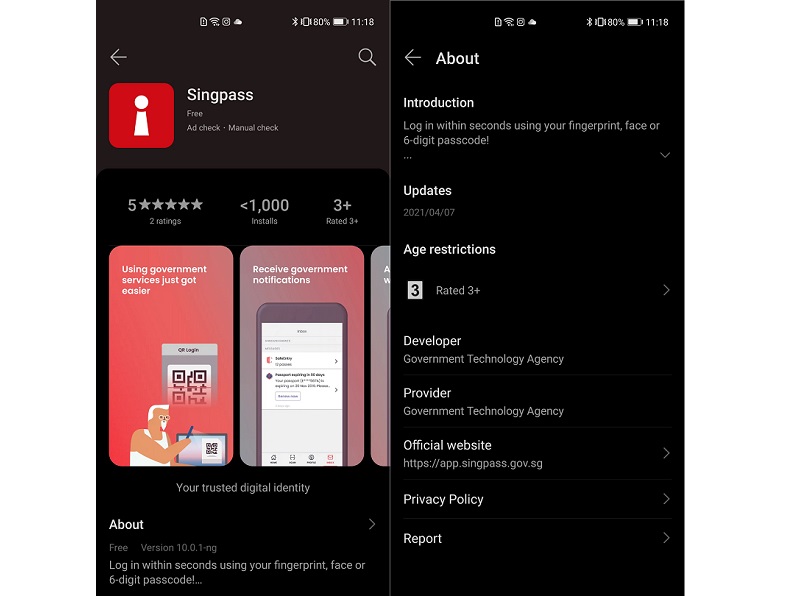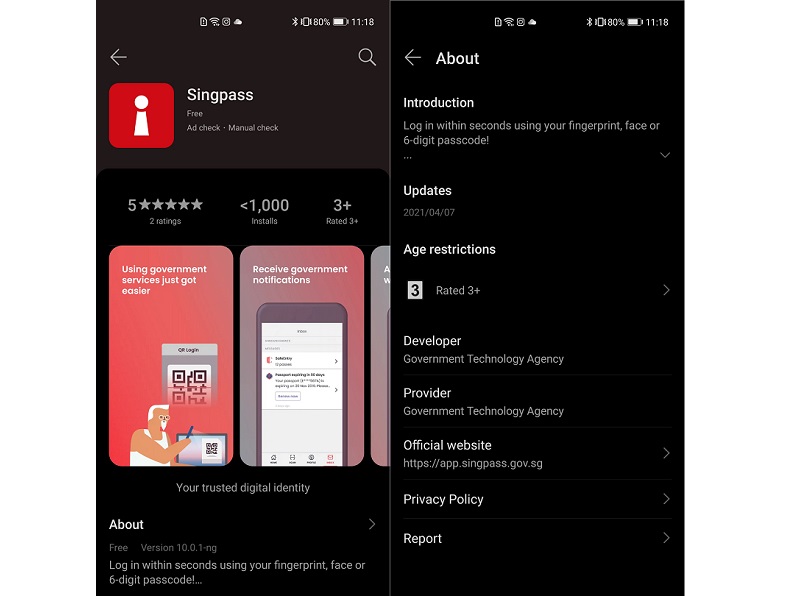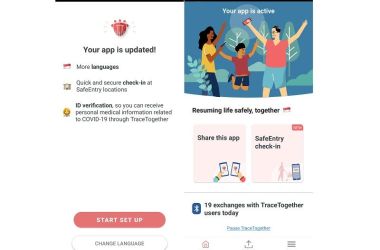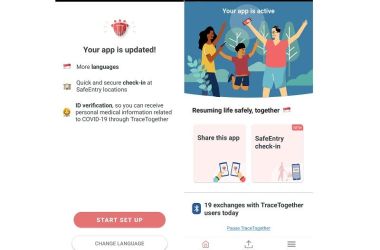Singpass has officially landed on Huawei AppGallery, bringing the Singapore government’s digital identity app directly to Huawei device users. The official Singpass app is now available for download from the Huawei app store, a development fans and users have long awaited given Singpass’s central role in accessing government services online. The arrival underscores Singpass’s status as one of the most requested and high-priority apps for Huawei’s ecosystem, reflecting the growing demand for seamless access to government portals across different device ecosystems. In Singapore, the Singpass platform is widely used to authenticate users across a broad swath of government-related websites and digital services, making its availability on AppGallery particularly timely and impactful. Huawei confirmed that the official Singpass app became available in the first half of this year, marking a notable milestone in the cross-platform distribution of national digital identity tools. For Huawei users, the path to installation is straightforward: simply open the Huawei AppGallery, type “Singpass” in the search bar, and the official app should appear for immediate installation. This development is set to enhance digital accessibility for Huawei users who rely on Singpass to access government services, especially those who may prefer or rely on Huawei devices and the AppGallery ecosystem. The broader implication is a shift toward more inclusive access to Singapore’s government digital services, irrespective of device choice, reinforcing Singpass’s central role in the nation’s digital infrastructure.
Overview: Significance of Singpass on Huawei AppGallery
Singpass represents more than a single app; it is the keystone of Singapore’s digital government framework, acting as the official digital identity that unlocks a wide array of public services online. The introduction of Singpass to Huawei AppGallery is therefore not merely about app availability; it broadens the accessibility arc for residents, workers, and visitors who use Huawei devices and rely on AppGallery as their primary app storefront. This move aligns with the broader push toward platform-agnostic digital access, ensuring that essential government services are reachable through multiple app ecosystems. For many users, Singpass is the gateway through which a diverse set of interactions with public agencies—from tax declarations to civil services and regulatory checks—are authenticated and streamlined. The decision to publish the official Singpass client on AppGallery signals a deliberate policy to reduce barriers to entry, especially for customers who favor Huawei hardware or who operate outside the Google Play ecosystem. As more government-related websites and portals increasingly rely on Singpass for authentication, the importance of having the official app available on all major app stores grows correspondingly. The first half of this year’s rollout marks a rapid expansion timeline that complements ongoing digital government initiatives and the broader modernization of public service delivery. End users benefit from a consistent, trusted entry point for identity verification across platforms, which is essential for maintaining security, reliability, and user confidence in accessing sensitive government services.
The availability in AppGallery also highlights Huawei’s ongoing commitment to expanding its app catalog with official, high-demand apps that citizens and residents rely on. This is part of a broader trend where platform providers emphasize legitimate, vendor-approved software to ensure security, privacy, and optimal performance. The official Singpass app, being a sanctioned component of Singapore’s digital identity framework, must meet stringent standards for authentication, data protection, and interoperability with government systems. By hosting Singpass directly within AppGallery, Huawei users gain a familiar, familiar-feeling experience designed for quick access and reliable operation. In practical terms, this translates into a smoother onboarding process for new users who may be unfamiliar with Singpass or with AppGallery’s navigation, as well as a more consistent user experience compared with third-party or unofficial versions. It also reinforces the idea that Singpass is a universally accessible service that does not hinge on a single device or storefront, thereby increasing resilience in the nation’s digital infrastructure.
For readers seeking a direct action, the recommended approach remains straightforward: on a Huawei device with AppGallery installed, search for Singpass, select the official app from the results, and install it. Once installed, users typically proceed with standard Singpass setup, which involves signing in with existing credentials and configuring security preferences such as PIN or biometric verification. The installation experience is designed to be intuitive, with the goal of minimizing friction so that users can quickly access a broad spectrum of government services. The broader impact of this development is the reinforcement of Singpass as a universal access point, capable of bridging several government portals and services through a single authenticated identity, now accessible from Huawei’s app storefront in addition to other platforms.
The rollout: Timeline, expectations, and user guidance
The rollout’s timing—achieved within the first half of the year—reflects a concerted effort to align with the public sector’s modernization timeline and citizens’ expectations for easier access to digital identity tools. The exact date of availability may vary slightly by device model, region, and AppGallery version, but the intent is clear: to provide an official, secure, and reliable Singpass experience to Huawei users who rely on AppGallery for their app needs. For users who are preparing to install, several practical steps help ensure a smooth setup. First, confirm that your Huawei device is running a compatible version of the operating system and that AppGallery is updated to the latest release. Second, open AppGallery and use the search function to locate Singpass. Third, select the official Singpass app from the search results—look for the publisher name that indicates official status—and tap install. After installation, launch the app and complete the standard Singpass sign-in flow using your existing credentials. If you haven’t set up Singpass before on another device, you may need to go through registration and verification steps that align with Singapore’s identity verification standards. Fourth, once signed in, configure your security preferences, such as a device PIN or biometric login, to ensure quick yet secure access in future sessions. Finally, test a couple of government service logins through Singpass to verify that authentication works as expected and that you can navigate to the services you need without complications.
Because government services increasingly depend on Singpass for access, having the official app on AppGallery improves reliability and reduces the risk of using unofficial or compromised alternatives. It also signals a mature, interoperable approach to digital government, where citizens can use multiple supported storefronts without losing the continuity or security of their digital identity. By ensuring Singpass is readily available on AppGallery, Singapore’s digital government ecosystem reinforces its commitment to inclusivity, allowing users who prefer Huawei devices or AppGallery as their primary store to participate fully in digital government services. The long-term expectation is that more government-related websites and portals will rely on Singpass authentication, further entrenching Singpass as a central, trusted identity verification mechanism across platforms and providers.
Section 2: Technical, Security, and Compliance Considerations
The official status of Singpass on Huawei AppGallery carries important technical and security implications that deserve careful consideration. Singpass is a national digital identity solution, and as such, its integrity, security, and privacy protections are foundational to public trust and the effective operation of Singapore’s government services. The app’s availability in AppGallery is contingent on compliance with strict security and interoperability requirements designed to protect user data and ensure smooth authentication across a wide range of government portals. From a technical perspective, the app is expected to function as a faithful representation of Singpass’s core identity verification capabilities, preserving the same user experience and security features that users encounter on other app stores. Huawei AppGallery’s deployment of the official Singpass client must align with the store’s security standards, including app vetting processes, regular scans for malware, and governance around app updates. In practical terms, this means that Huawei users can trust that the Singpass app downloaded from AppGallery has undergone official verification and is maintained by the same authorities responsible for Singpass on other platforms. The result is a consistent, trustworthy entry point for authentication that aligns with Singapore’s digital-security posture.
Security and privacy considerations are central to any government-authenticated app, but Singpass’s role amplifies their importance given the breadth of services it unlocks. Singpass is designed to handle sensitive information and perform critical identity verification tasks. Users can expect that the app adheres to rigorous security standards, including safeguarding login credentials, protecting personal data, and supporting secure communication with government servers. The integration of Singpass with AppGallery must preserve these protections, ensuring that data transmitted during authentication remains encrypted and that user consent and control mechanisms remain clear and robust. Privacy protections revolve around data minimization, purpose limitation, and transparency about how data is used once authentication has occurred. While Singpass is designed to minimize unnecessary data sharing, the realities of accessing a wide range of government services mean that some data may be accessed or verified to fulfill service requests. The official app’s presence on AppGallery should not alter these fundamental privacy principles; instead, it should provide the same level of privacy protection and user control that Singpass users expect.
From a compliance perspective, the integration with AppGallery must reflect Singapore’s regulatory landscape and the government’s standards for digital identity solutions. This includes adherence to identity verification protocols, data protection rules, and interoperability specifications that enable Singpass to authenticate users consistently across different services and portals. The cross-platform availability reinforces the importance of compliance, as government-backed apps must function reliably across devices and app stores to avoid fragmentation in service delivery. Users can benefit from a more consistent experience when authenticating on government sites, with fewer compatibility issues or inconsistent performance between platforms. This consistency is crucial for building and maintaining public trust in digital identity services, particularly as more citizens rely on smartphones to access essential government functions.
In addition to security and privacy considerations, the practical implications of Singpass on AppGallery include performance, compatibility, and user experience. Huawei devices vary in terms of hardware specifications and software customizations, so ensuring that the Singpass app runs smoothly across a broad range of Huawei models requires ongoing optimization and testing. Huawei’s app ecosystem—especially in environments without Google Mobile Services—calls for careful attention to app integration, permissions handling, and secure storage of credentials on the device. The official Singpass app on AppGallery should be optimized to work well with Huawei’s hardware and software layers, providing a seamless login experience that matches the performance users expect from Singpass on other platforms. Users should also be mindful of app maintenance cycles; installing the official app means receiving updates and security patches through AppGallery, ensuring that the app remains aligned with evolving security standards and government service requirements.
For those weighing the decision to install Singpass from AppGallery, the security signals remain positive. The process emphasizes official status, regular updates, and adherence to national security standards. The potential risks associated with unofficial or third-party versions are mitigated by the presence of the official app in a trusted store and the ongoing governance surrounding digital identity tools. In short, the AppGallery deployment of Singpass preserves the critical balance between accessibility, security, and privacy while extending the reach of Singapore’s digital identity system to Huawei users.
Installation guidance and best practices
To maximize the benefits of Singpass on AppGallery, users should follow best practices during installation and first-time setup. Start by verifying that your Huawei device has sufficient storage space and is running a supported version of the operating system that is compatible with the Singpass app. Open the Huawei AppGallery and utilize the search function to locate the official Singpass app. When you locate the app, confirm that you are selecting the official version published by the Singpass or Singapore government publisher to avoid any potential counterfeit or misrepresented alternatives. Proceed with the installation and wait for the download to complete. After installation, launch the app and begin the sign-in or registration process, depending on whether you already have Singpass credentials. If you are an existing Singpass user, you should be able to sign in using your current credentials and complete any required two-factor authentication steps as part of the login flow. If you are new to Singpass, you will need to complete the registration steps, which typically involve identity verification using government-issued information as part of the national digital identity framework.
During first-time use, it is advisable to configure security preferences within the app. This often includes setting up a secure login method such as a device PIN, biometric authentication (where supported by your device), or a combination of these to ensure a fast but secure access to the app and the authenticated government services it unlocks. If your device supports biometric login, enabling fingerprint or facial recognition can speed up future sign-ins and enhance convenience without sacrificing security. It is also prudent to review the app’s privacy and data handling settings to understand what information is accessed during authentication and how it is used for the services you access. In case you encounter any connectivity or performance issues, checking for the latest AppGallery updates or Singpass app updates may resolve inconsistencies in service delivery or authentication flows. Users should also be aware of best practices for maintaining device security, including staying current with operating system updates, applying security patches, and avoiding the installation of unofficial versions of Singpass or any other government app from unverified sources. By following these steps and best practices, Huawei users can enjoy a reliable, secure, and efficient Singpass experience within the AppGallery ecosystem.
In sum, the Singpass app’s presence on Huawei AppGallery represents a meaningful step toward broader digital inclusion and a more resilient public service environment. It provides Huawei users with a direct, official route to authenticate themselves for a wide range of government services, reinforcing the notion that digital identity and public service access should be device-agnostic and platform-agnostic wherever possible. The combined effect of this rollout is an enhanced user experience, improved security through official channels, and reinforced public trust in Singapore’s digital government initiatives as they expand across app ecosystems and device families.
Section 3: Adoption, Usage, and Broader Implications
The integration of Singpass into Huawei AppGallery carries practical implications for user adoption, government digital strategy, and the overall functioning of public services. With Singpass already serving as the primary gateway to authentication across an expanding set of government portals, extending its availability to AppGallery broadens the potential user base and reduces barriers for individuals who rely on Huawei devices. From a user perspective, this means easier access to essential digital services, fewer compatibility concerns, and a more consistent authentication experience across platforms. It also means that Huawei users can enjoy the same streamlined login flow and security protections associated with Singpass, reinforcing universal access to Singapore’s digital government infrastructure. Over time, the increased visibility and availability of Singpass on AppGallery are likely to correlate with higher adoption rates among Huawei users, who may previously have faced hurdles in obtaining or updating the official Singpass app on alternative stores. The convenience factor—having a trusted, official app available directly within AppGallery—can contribute to higher engagement with government services, reducing friction and encouraging residents to complete digital interactions more efficiently.
From a broader strategic standpoint, the Singpass-AppGallery collaboration aligns with Singapore’s digital government strategy, which emphasizes secure, accessible, and scalable identity solutions. The public sector’s ongoing efforts to centralize authentication through Singpass reflect a commitment to streamlining user experiences, minimizing repetitive credentialing, and enabling seamless access to a growing ecosystem of public services. The presence of Singpass in AppGallery also signals to other platforms and app stores that Singapore’s digital identity framework is a critical, cross-platform asset. While some users may still rely on other ecosystems or devices, this development demonstrates a flexible, multi-store approach that honors user choice while maintaining consistent security standards and service reliability. The net effect is an ecosystem where Singpass remains a trusted, universal entry point for public-service access, now available to even more users through Huawei’s store.
For Huawei and AppGallery, this move reinforces the store’s relevance in regions where Singpass is a central government authentication tool. By offering an official government app in AppGallery, Huawei demonstrates a commitment to meeting user needs and expanding the ecosystem’s legitimacy with official, high-profile software. This can also foster more confidence among Huawei users who may have previously faced limitations in accessing government services on their devices. The impact on developers and public agencies is to maintain cross-platform compatibility, ensure consistent identity verification experiences, and support a uniform set of APIs and security standards across stores. The resulting interoperability can reduce fragmentation in digital service delivery and lead to better outcomes for citizens who rely on rapid, secure access to government portals from diverse devices.
Looking ahead, several likely developments may shape the continued role of Singpass on Huawei AppGallery. First, as Singapore’s digital government continues to evolve, more services and portals may adopt Singpass-based authentication, further centralizing identity verification and enabling more streamlined access for AppGallery users. Second, ongoing collaboration between Singapore’s government and Huawei could yield additional enhancements, such as improved performance for authentication, more robust privacy protections, and broader support for accessibility features within the Singpass app on AppGallery. Third, there could be continued attention to the user experience, including clearer onboarding, improved error handling, and more consistent messaging across services that rely on Singpass for authentication. These potential futures all hinge on maintaining a secure, reliable identity framework that users trust, while expanding the convenience and reach of government services to a broader audience of device owners.
A successful rollout of Singpass on AppGallery also offers an opportunity to reflect on the broader role of digital identity in public administration. Digital identity is more than a login credential; it is the foundation for trusted interactions between citizens and government entities. As such, ensuring that Singpass remains secure, privacy-preserving, and user-friendly is essential to maintaining confidence in digital services. The AppGallery deployment underscores the necessity of robust governance around identity ecosystems, including ongoing audits, timely updates, and transparent communication with users about how data is accessed and used. In this sense, the Singpass-AppGallery collaboration serves as a case study in how national digital identity tools can be extended to diverse platforms while preserving core security principles and user rights. For policymakers, technologists, and the public, this development highlights the importance of interoperability, accessibility, and security in delivering modern, efficient public services.
Conclusion
The official entry of Singpass into Huawei AppGallery marks a pivotal moment for both Singapore’s digital government and Huawei’s app ecosystem. Huawei users now have direct, official access to Singpass through the AppGallery, simplifying authentication for a broad range of government services and reinforcing Singpass’s role as the central digital identity for Singapore. This move addresses a long-standing demand among Huawei device owners and reflects Singapore’s commitment to platform-agnostic access to essential public services. By enabling easy discovery and installation—simply search for Singpass in AppGallery and follow the standard setup—Huawei users can begin leveraging Singpass to engage with government portals more efficiently. The rollout in the first half of the year demonstrates a proactive approach to expanding digital inclusion and ensuring that critical government tools remain accessible across major app stores. In a landscape where more government websites rely on Singpass for authentication, making the official app available on AppGallery helps maintain service continuity, security, and user trust. The result is a more seamless, secure, and inclusive digital experience for citizens and residents who rely on Huawei devices, as well as a stronger, cross-platform digital identity framework that supports Singapore’s ongoing digital transformation.



